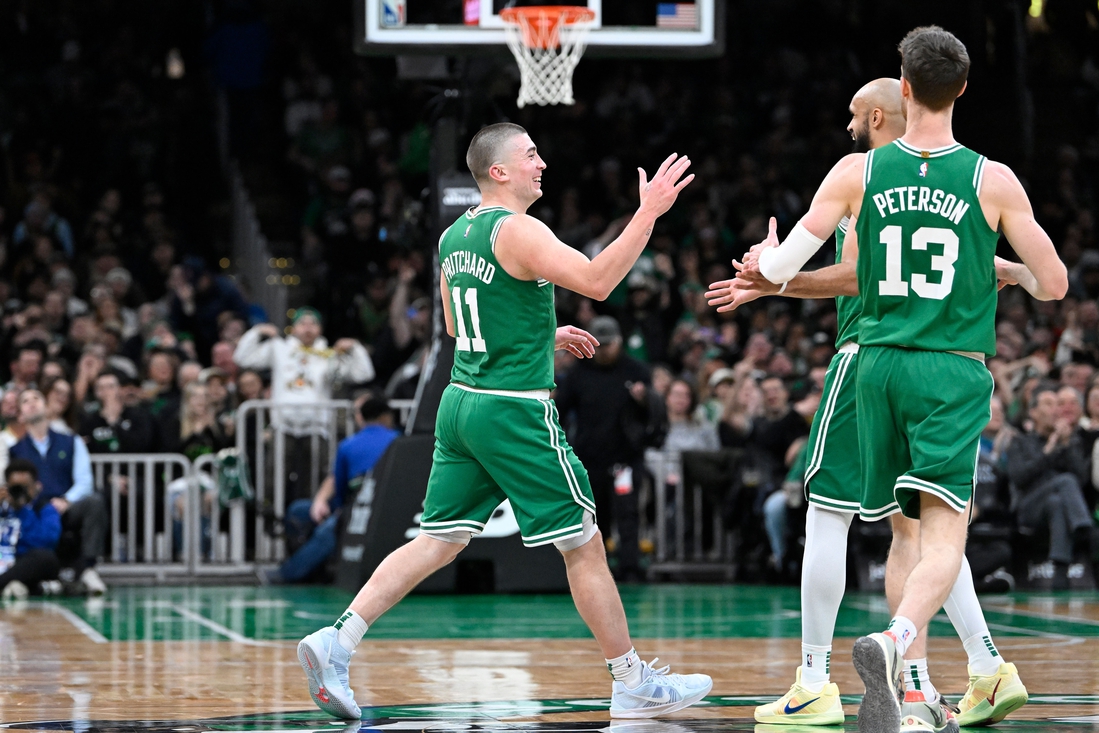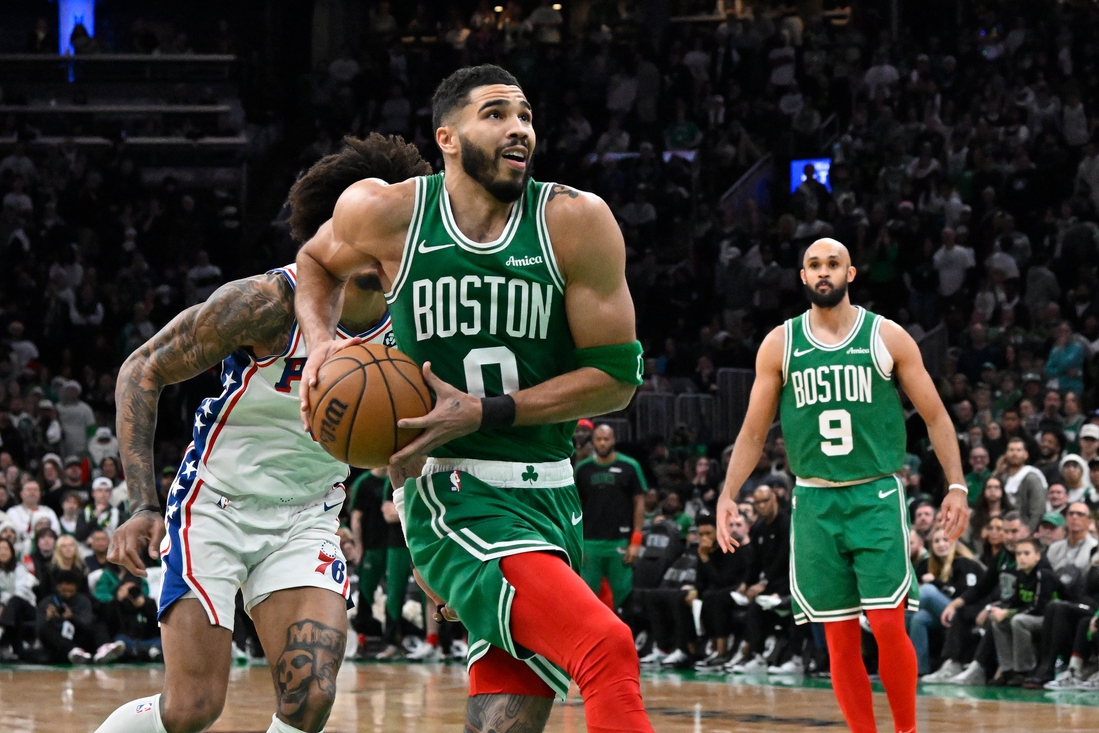Is LeBron James’ hold over the Eastern Conference coming to an end? For the first time in eight years, James’ team is trailing a playoff series by two games.
The team leading 2-0 in the Eastern Conference finals is one that’s missing two of its three highest-paid players, and it struggled in the first round nearly as much as the Cleveland Cavaliers did.
Forget what we’ve seen from Cleveland all season; if you watched the Boston Celtics through six games against the Milwaukee Bucks, you’d have a hard time believing they’d win seven of their next eight playoff games, posting the best NetRtg (point differential per 100 possessions) during that stretch.
So how did this happen? Here are some key numbers about the Celtics and Cavs, with the series taking a break before Game 3 resumes in Cleveland on Saturday (8:30 p.m. ET, ESPN).
Celtics scoring without their leading scorer
The Celtics ranked 18th offensively in the regular season, just below the league average in effective field goal percentage, offensive rebounding percentage, and free throw rate, and right at the league average in turnover rate.
They ranked third in effective field goal percentage from outside the paint but were 28th in field goal percentage in the paint. In 22 games without Kyrie Irving, they scored only 102.6 points per 100 possessions (which would have ranked 25th).
In the playoffs, the Celtics have scored more efficiently (107.7 points per 100 possessions) than the Cavs (107.4). Boston is one of only two playoff teams (Indiana was the other) that have scored more efficiently in the postseason than during the regular season.

Offensive rating difference, regular season to playoffs
Through the first two rounds, the Celtics’ effective field goal percentage dipped, but they cut down on turnovers and saw an increase in free throw rate. In the conference finals, they’ve been able to attack the basket more often, with 38 percent of their shots coming in the restricted area, up from 32 percent in the first two rounds.
That’s partly due to playing against a weak defensive team. The Cavs ranked 29th in defense this season. In the past 40 years, no team ranked in the bottom three defensively in the regular season has won a playoff series.
So the Cavs have already made history, but it’s not a coincidence that the only other team to score more points per 100 possessions in the playoffs than in the regular season is the team they faced in the first round—the Indiana Pacers.
Even though the Cavs swept the Toronto Raptors in the conference semifinals, the Raptors were just as efficient offensively in that series (110.1 points per 100 possessions) as they were in the first round (110.2).
But the Celtics’ offense had improved even before this series. They’ve been highly balanced, with six players in their rotation having a postseason usage rate between 19.6 and 24.0 (none higher than 28th overall in these playoffs). As Al Horford mentioned after Game 1, they’ve found “what fits this group.” They’ve also found, especially against the Philadelphia 76ers and Cavs, matchups to exploit. They’ve been executing with precision and patience.
Cavs’ not-so-great shots
Two major issues stand out with the Cleveland offense as it has scored under a point per possession in each of the first two games.
First, LeBron James has only 18 total points in the restricted area, after averaging a postseason-high 14.4 points per game in the restricted area through the first two rounds. The Celtics have been effective in transition (with the Cavs scoring just 16 total fast break points) and in staying in front of James in half-court situations.
Even when James scored 21 points in the first quarter of Game 2, five of his eight field goals came from outside the paint. Over the two games, only 27 percent of his shots have been taken in the restricted area, compared to 41 percent through the first two rounds.
James has shot 77 percent in the restricted area and 29 percent from three-point range in the playoffs, so if most of his offense continues to come from the perimeter, the Celtics are in a good position.
The second issue with Cleveland’s offense in Games 1 and 2 is their poor shooting from the corner three-point line: the Cavs have made just 1-for-10 corner threes.
Game 1 was the fourth time this season the Cavs failed to make a corner three, and these two games mark the third time in the last four seasons since James returned to Cleveland that they’ve made fewer than two corner threes in a two-game stretch.
The lack of corner threes is another factor setting apart the Toronto series from the other two the Cavs have played. They averaged 5.3 per game against the Raptors but just 2.3 against the Pacers, and now 0.5 against the Celtics.
This lack of corner threes is linked to James’ lack of shots in the restricted area. Since the Celtics have done a solid job staying in front of James, they’ve been able to stay close to the Cavs’ shooters. If the Cavs can get their star to the basket, it will force the Boston defense to adjust, opening up other scoring opportunities.

Matching up down low
The Cavs started Tristan Thompson in Game 2, thinking he would have an advantage, especially on the boards, against Al Horford. Last year in the conference finals, the Cavs outscored the Celtics by 81 points in 134 minutes when both Thompson and Horford were on the floor.
In this series, the Cavs have been a plus-4 in 18 minutes with Thompson on the floor and Horford at center, which could keep Thompson in the starting lineup for Game 3. Despite being outscored by 38 points in the series, Cleveland should find some confidence in any lineup that has produced a positive point differential.
Before Game 2, Celtics coach Brad Stevens mentioned he wouldn’t change his starting lineup if the Cavs did. However, the Celtics didn’t let the Horford-Thompson matchup last too long, especially in the second half when Aron Baynes replaced Jayson Tatum less than 2 ½ minutes into the third quarter.
Thompson has played more minutes (20) in this series with Horford at power forward (alongside Baynes or Greg Monroe) than when Horford is at center (18). In those 20 minutes with Thompson on the floor and Horford at power forward, the Celtics outscored the Cavs by nine points.
Will a change of venue matter?
With their wins in Games 1 and 2, the Celtics are 9-0 at home in the postseason. If they stay undefeated at TD Garden, they will win the series. However, the Celtics have been significantly better at home, with a NetRtg of plus-10.8, compared to minus-9.4 on the road.
Their only road win (Game 3 at Philadelphia) came in overtime, and the only team with a larger home-road NetRtg difference (26.5) than the Celtics is Milwaukee, whom the Celtics faced in the first round.
The Cavs are 5-1 at home and have been 11.7 points per 100 possessions better at Quicken Loans Arena than on the road in the playoffs. However, four of those five home wins have been by four points or fewer, meaning they haven’t exactly been dominant at home.
